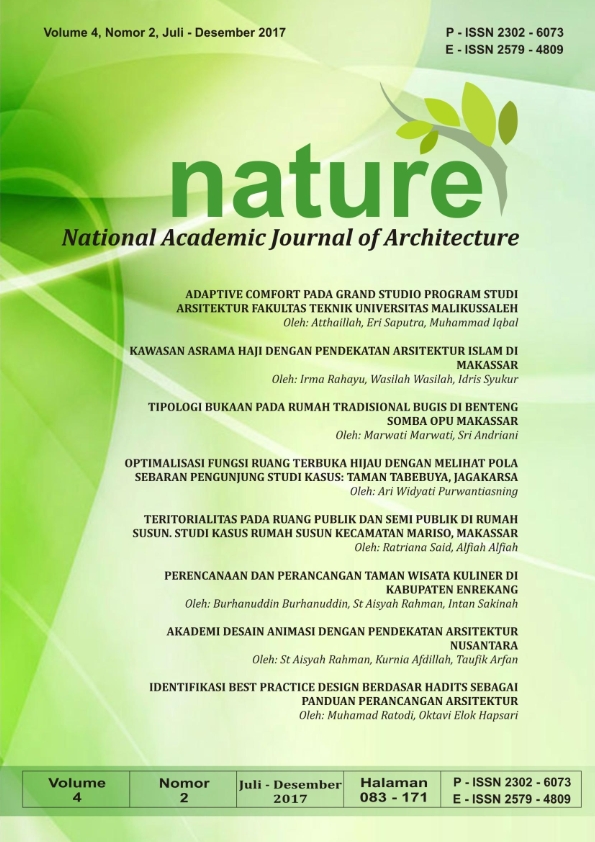TERITORIALITAS PADA RUANG PUBLIK DAN SEMI PUBLIK DI RUMAH SUSUN (STUDI KASUS : RUMAH SUSUN KECAMATAN MARISO MAKASSAR )
Abstract
Abstrak_ Penelitian dilatarbelakangi oleh adanya fenomena ketidaksesuaian jenis ruang yang tersedia di rumah susun dengan pemanfaatannya. Indikasi perubahan fungsi ruang ini terlihat dimana teritori publik dan semipublik banyak yang dimanfaatkan untuk kepentingan pribadi.Hal ini berpotensi menimbulkan konflik spatial, menurunkan kualitas fisik ruang dan kualitas kehidupan penghuninya sendiri.Tujuan penelitian ini untuk mengetahui gambaran karakteristik pemanfaatan ruang dan teritorialitas yang terdapat di ruang publik dan semi publik sebagai fasilitas rumah susun.Metode yang digunakan dalam penelitian ini adalah dengan melakukan pemetaan perilaku penghuni terhadap ruangnya (place centered map), interview dan diklasifikasi secara deskriptif.Berdasarkan penelitian teridentifikasi sebanyak sembilan pola territory yang terbentuk berdasarkan pemanfaatan ruang dan perletakan benda pribadi yang sebagian besarnya ternyata terjadi pada area territory yang terdekat dengan unit hunian penghuni.
Kata kunci : Teritorialitas, Ruang Publik dan semipublik, Rumah Susun.
Abstract_ The study is motivated by the phenomenon of mismatchingbetween the facilities available and the utilization. This is indicated by the deviation of space function, where the public and semipublic territory mostly used for other personal purposes. It is also potentially lead to conflicts of spatial, reduce the quality of space and the quality life of residents. The study purpose is to describe the characteristics of the space utilization and territoriality contained in the public and semi-public space as facilities flats. The method used is by mapping the residents’ behavior towards a space (place centered map), interviews and classified descriptively. The results of identification, there are nine patterns of territory formed based on the utilization of space and the placement of personal objects and mostly occurred on the territory area which is close to residential unit.
Keywords : Territoriality, public and semipublic space, flats.
Downloads
References
Holahan C.J. (1982). Environmental Psychology. New York, Random House.
Caroline Holland, Andrew Clark, Jeanne Katz, Sheila Peace, Jeanne Katz. (2007). Social interactions in urban public places. The Open University, 12(1):1–84,
W P Blauw. (1993). The meaning and use of public space, chapter The meaning and use of housing, page 239-251. Aldershot, Averbury: Ashgate Publishing Ltd.
Edward T Hall. (1990). The Hidden Dimension. Anchor Books.
M. Kärrholm. (2012). Retailing Space Architecture, Retail and the Territorialisation of Publik Space, vol. 1. Ashgate Publishing Limited.
D. A. Snow, P. J. Leahy, and W. A. Schwab. (1981). “Sosial interaction in a heterogeneous apartment: An investigation of the effects of environment upon behavior,” Sociol. Focus, vol. 14, no. 4, pp. 303–319.
Haryadi and B. Setiawan. (1995). Arsitektur Lingkungan dan Perilaku : Pengantar ke Teori, Metodologi dan Aplikasi. Gadjah Mada University Press.
Ratriana. (2003). Perancangan Rumah Susun dengan pertimbangan perubahan ruang sebagai akibat perilaku penghuni. Studi Kasus Rumah Susun Sarijadi, Bandung, Indonesian. Master’s Thesis, Institut Technology Bandung. pp. 7
Indiyastari Wikan Ratih. (2006). Kajian Tingkat Kepuasan Penghuni Terhadap Pemanfaatan Ruang Publik di Rumah Susun Kemayoran. Master’s Thesis. Institut Teknologi Bandung.
Kavita Datta and Gareth A. Jones. (2001). Housing and finance in developing countries: Invisible issues on research and policy agendas. Habitat International, 25(3):333–357.
Mauricio Hernandez Bonilla. (2013). The significance and meanings of publik space improvement in low-income neighbourhoods ’colonias populares’ in Xalapa-Mexico. Habitat International, 38(1):34–46.
M. Syaom Barliana and Enok Maryani. (2008). Perilaku spasial terhadap modal social bagi pendidikan ips. Mimbar Pendidikan, Universitas Pendidikan Indonesia, XXXII(2).
StanfordM. Lyman and Marvin B Scott. (1967). Territoriality: A neglected sociological dimensions. Social Problem, 15:236.
Zhonghua Huang and Xuejun Du. (2015. Assessment and determinants of residential satisfaction with public housing in Hangzhou, China. Habitat International, 47:218–230.
Galih Widjil. (2012). Pendekatan Teritori Pada Fleksibilitas Ruang Dalam Tradisi Sinoman Dan Biyada Di Dusun Karang Ampel Malang. DIMENSI (Journal of Architecture and Built Environment), 39(2):65–75.
Irwin Altman. (1975). The environment and Sosial Behavior : Privacy, Personal Space, Teritori, Crowding. Brooks/Cole Publishing Co. pp : 114-116
Aidan Sammons. (2009). Territoriality-psychology teaching resources, Epub EBook, 2009 pp 1-4
(http:// www.psychlotron.org.uk diakses tgl 26 November 2016)
Copyright (c) 2018 Ratriana Said, Alfiah Alfiah

This work is licensed under a Creative Commons Attribution-ShareAlike 4.0 International License.
By submitting your manuscript to our journal, you are following Copyright and License











